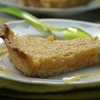How to Zest a Lemon or Orange
Here's a little review of how to zest a lemon, an orange or any other citrus fruit. Zest is often an ingredient in French recipes and shouldn't be skipped.
What is Zest?
Zest is just the very outer, brightly colored portion of the peel of a citrus fruit. The white layer that comes after is called the pith. Normally you do not want the pith in your recipes because it may add a bitter taste. The zest of a citrus fruit packs a powerful punch of flavor which will really brighten up your dish, so don't skip it if your not sure how to zest a lemon or orange.

Get Zesting
Many times citrus fruit are treated with a protective coating of wax. If at all possible, you should buy untreated fruit when you are going to use them for zesting. However, I have to admit, I've probably put some wax into various dishes through the years. In any case, you should definitely wash the fruit with warm water and then thoroughly dry it with a clean towel before zesting.
Method 1. Use a vegetable peeler. Everyone has one of these in the kitchen drawer. Use a light touch because you want to get just the very outer layer of your fruit. You can quickly remove all the zest from an orange or lemon with a vegetable peeler, but you will then need to chop it finely for most recipes.
Method 2. Use a zester! This takes a little more patience then a vegetable peeler but you will end up with lovely little strips of zest, which can be used to decorate your masterpiece. For most recipes though, you may want to then chop the zest more finely.
Method 3. Use a Microplane grater. This must be the cooking tool of the decade based on its enormous popularity. It makes quick work of a lemon or orange, and the resulting grated zest is just right for adding to many recipes.
Using Zest
Zest can be used to flavor any number of dishes. It has the advantage of not adding any liquid or acid that could potentially change a dish. All you get is the great flavor.
Zesty recipes . . .



New! Comments
Have your say about what you just read! Leave me a comment in the box below.